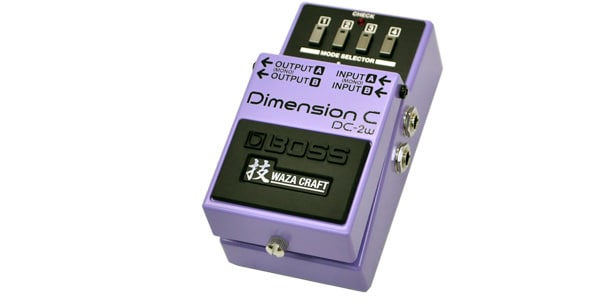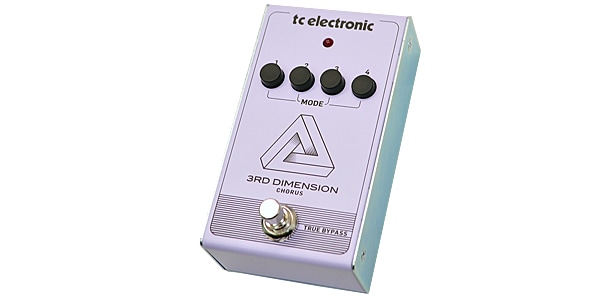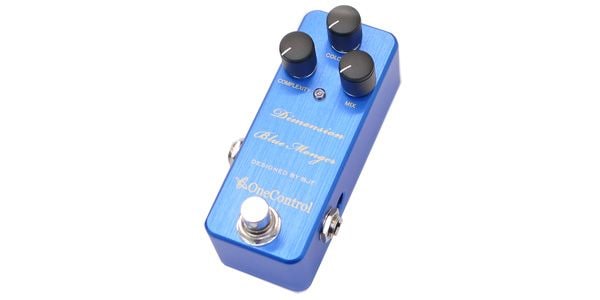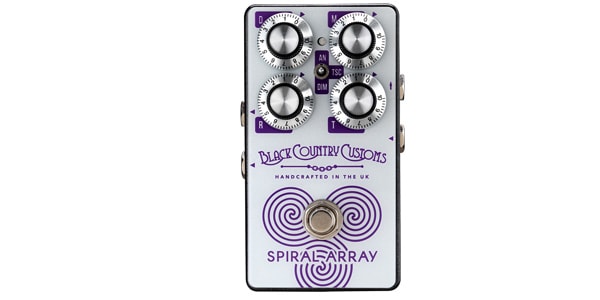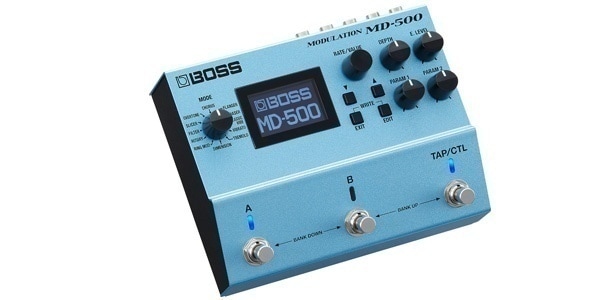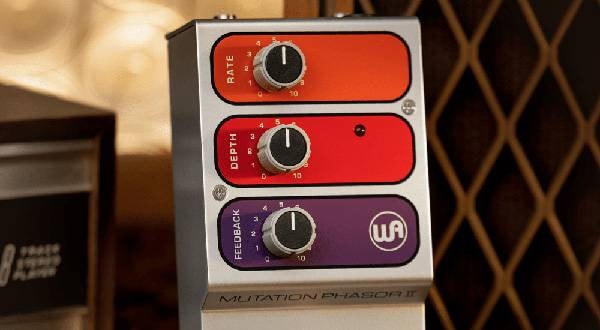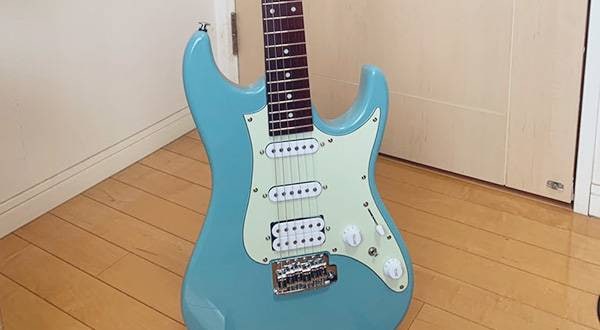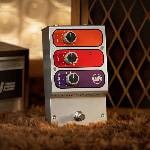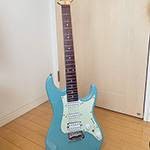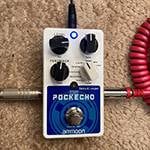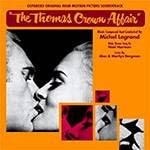This time, I will feature the "Dimension Chorus" in response to a request.
First of all, for those who do not know, here’s a rough explanation.
The theory section becomes quite troublesome due to various circumstances, so I will leave that to the end.
Dimension chorus is a general term for "non-fluctuating" choruses such as the Roland SDD-320 and "Dimension D".
I will explain the reason why it does not fluctuate later, but you can apply a transparent effect with no fluctuation in the pitch of the normal chorus, but the spread of the sound is the chorus itself.
There are very few new dimension choruses available today, and I only see four stompboxes and one multi-effector.
I’ll introduce them.
BOSS / DC-2W Dimension C
This is the revival of the BOSS DC-2 in the skill craft series.
Equipped with Standard mode and SDD mode, both the sound of DC-2 and the sound of SDD-320 are reproduced.
Using an analog circuit, up to two of the four preset buttons can be pressed at the same time. It is a stomp box that inherits the specifications of the original SDD, with stereo sound.
TC ELECTRONIC / 3RD DIMENSION CHORUS Chorus Pedal
This is a copy of the DC-2 by TC ELECTRONIC, and like both the DC-2 and the SDD-320, you can press four preset buttons at the same time.
It uses an analog circuit with a BBD element like the DC-2W, and can provide the high quality dimension chorus.
It is one of the cheapest dimensional choruses available.
One Control / Dimension Blue Monger
This is a dimension chorus designed by BJF.
The modulation is referred to as the "Watery" or "liquid-like" fluctuation between a chorus and a flanger.
It is an effector that gives you various expressions from a light to a deep spread by operating the overlap of complicated fluctuations with three knobs.
It is also an advantage that it is the smallest unit amongst dimension choruses.
Laney / SPIRAL ARRAY
This is a 4-knob chorus, but you can select from three choruses: analog, digital, and dimension with the selector. The appeal of this is that you can use it as a normal chorus, and even if as a dimension chorus, and you can finely adjust the settings. In addition, it is a hybrid stomp box that is different from the above two, such as having an "Expression" terminal on the input side.
BOSS / MD-500 MODULATION
This is a multi-effector unit that contains 12 types of modulation.
As the name implies, not only chorus but also rotary and tremolo are available, and dimension chorus can be used as an option.
In addition to this, there are some from Yamaha and Behringer, but I will omit them because they are not available any more.
Currently, Yamaha's Dimension Chorus is often sold with a premiere price in the second-hand market.
It's a 4-knob, plastic housing stomp box, but it wasn't well received.
Behringer's Dimension Chorus is not widely available even if it is used, and it is a model that does not appear so much even on major online shops.
As far as you can see from the photo, there are parts that are created from existing parts, such as using the tuner switch which is used as a preset button. But this seems to be regarded as the cheapest DC-2 copy.
■ The Theory: Reasons for not fluctuating and how they are different from the normal chorus
It is too much to explain completely, so I will only explain it roughly.
I'll skip the basics here and focus only on the explanation of the dimension chorus.
The dimension choruses introduced so far basically have a circuit that can be said to be upward compatible with the chorus.
Because the dimension chorus is made by combining two or more basic chorus circuits, they can be used as a normal fluctuating chorus while using only one of them.
So, let's start with a brief explanation of chorus.
For the principle, Wikipedia's chorus (acoustic equipment) page and flanger page are detailed, but in short, it is fluctuation by "dividing the input sound into two and delaying one sound slightly".
Actually, there is a misnomer in that this is delayed, but the delay time is constantly changing inside the chorus.
If the delay time is constant, it will be a detune or delay, not a chorus, but if the delay time goes up and down periodically, the delay time will be close to the original sound while the delay time is close to 0. When it is extended, it is expanded in the time direction from the original sound, and when the time is shortened, it is compressed more than the original sound.
When a sound wave is compressed in the time direction, it means that the frequency goes up, and conversely, when it is expanded, it means that the frequency goes down.
By mixing a sound whose frequency goes up and down with the original sound, the fluctuation peculiar to the chorus can be obtained, but when it comes to the dimension chorus, this fluctuation is added.
This is a chorus of opposite phase, but it is easier to understand if you graph only the "upper and lower frequencies".
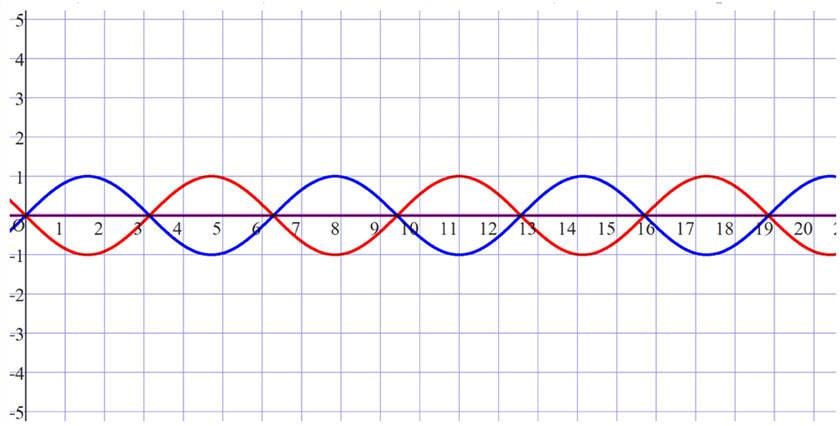
The vertical axis is frequency and the horizontal axis is time.
The purple straight line is the original sound, and the blue wave is the frequency of the chorus sound (processed as y = sinx in the graph).
If you take the opposite phase of this chorus sound, you will get a red wave (processed as y = sin (-x)).
And when this blue wave and red wave are combined, it becomes a purple wave.
In other words, the final pitch does not fluctuate, and you can obtain a dimension chorus sound that does not fluctuate while applying the chorus effect.
Of course, in the actual effector, it is difficult to say that the LFO waveform that determines the compression time is not completely fluctuated due to errors such as disturbance, but in principle, it can be explained by canceling the pitch wave in this way.
I made a sound source for reference.
There are three types: a 440Hz sine wave, a sine wave that raises and lowers the pitch, and an opposite phase.
The sine wave + chorus + anti-phase sound has become so beautifully constant pitch that I intentionally shifted the phase so that it is not completely opposite.
sine wave
Dimension chorus sound
Again, this commentary skips most of the underlying physics and mathematics and only explains the dimension chorus, assuming there is a chorus.
If you want a more detailed explanation, I recommend you to investigate the principle of dimension chorus or make your own.
You can use the IC PT2399 delay, the LFO XR2206, and the inverting output of the dual operational amplifier.
That's it for this time.
I’m writing a large article with the goal of mid-February-early March, so stay tuned.
コラム「sound&person」は、皆様からの投稿によって成り立っています。
投稿についての詳細はこちら





